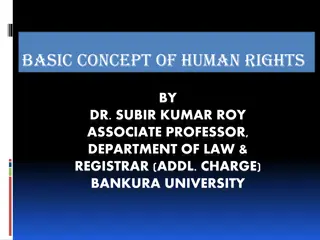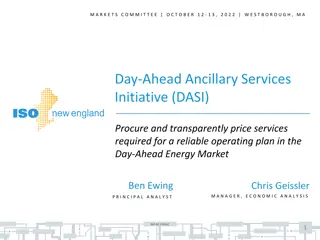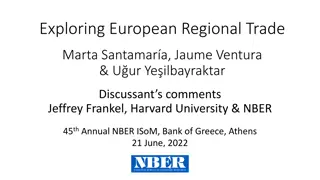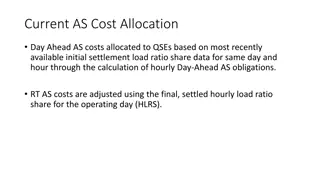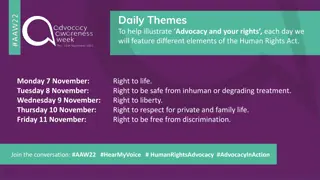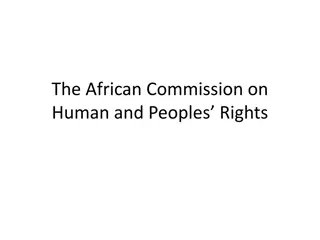Using Ancillary Tools to Promote Human Rights in Trade
Exploring the use of ancillary tools like Free Trade Agreements (FTAs), Withhold Release Orders (WROs), Uyghur Forced Labor Prevention Act (UFLPA), sanctions, and AD/CVD duties to promote human rights in trade. Discussing the evolution of modern views on the intersection between human rights and trade, enforcement mechanisms, and the effectiveness of these tools.
Uploaded on Oct 01, 2024 | 3 Views
Download Presentation

Please find below an Image/Link to download the presentation.
The content on the website is provided AS IS for your information and personal use only. It may not be sold, licensed, or shared on other websites without obtaining consent from the author.If you encounter any issues during the download, it is possible that the publisher has removed the file from their server.
You are allowed to download the files provided on this website for personal or commercial use, subject to the condition that they are used lawfully. All files are the property of their respective owners.
The content on the website is provided AS IS for your information and personal use only. It may not be sold, licensed, or shared on other websites without obtaining consent from the author.
E N D
Presentation Transcript
Human Rights and Trade: Using Ancillary Tools as Carrots and Sticks to Promote Human Rights JUSTIN BECKER STACY ETTINGER LARA HAKKI LAUREN SHAPIRO LAVENDER LAW 2023 1 LAVENDER LAW 2023
Overview Evolution of modern views on trade and the resulting intersection between trade and human rights Carrot: Free Trade Agreements (FTAs) Recent human rights provisions in FTAs Enforcement of FTAs Stick: Withhold Release Orders (WROs), Uyghur Forced Labor Prevention Act (UFLPA), sanctions, and antidumping and countervailing duties (AD/CVD) Overview of WROs, UFLPA, and sanctions promoting human rights Enforcement of WROs, UFLPA, and sanctions Imposition of AD/CVD duties Promoting human rights through FTAs, WROs, UFLPA, sanctions, and AD/CVD duties vs. other international agreements and conventions Future use of FTAs, WROs, UFLPA, sanctions, and AD/CVD duties and whether they are or will be effective and should be used 2 LAVENDER LAW 2023
The Evolution of Modern Views of Trade and the Resulting Intersection Between Human Rights and Trade Post-WWII: Creation of economic/non-economic distinction Transition Post-Cold War: Rise of regulatory states 1980s-1990s: Aspirational and non-binding human rights language in some preferential trade agreements NAFTA 1993: Labor and environment side agreements, rise of international environmental movement World Trade Organization (WTO) preamble: Sustainable development and trade Transparency and China problem Recognition of externalities and new generation of trade agreements: U.S.-Mexico-Canada Agreement (USMCA or NAFTA 2.0), Comprehensive and Progressive Agreement for Trans-Pacific Partnership (CPTTP), etc. Demise of the dispute settlement mechanism 3 LAVENDER LAW 2023
Carrot: Introduction to FTAs Primary purpose: to facilitate trade and eliminate trade barriers between two or more countries Reduce tariffs, quotas, or other impediments to imports and exports between the parties Provide for a more stable and transparent trading and investment environment with enhanced rule of law (e.g., dispute resolution mechanisms, intellectual property right protections) Offer opportunities to sell to the government through procurement contracts Provide protections and rights to private parties such as investors Examples of FTAs USMCA: Successor to NAFTA CPTTP WTO and the General Agreement on Tariffs and Trade (GATT) The U.S. has FTAs with 20 countries 4 LAVENDER LAW 2023
Recent Human Rights Provisions in FTAs Labor: Chapter 23 of the USMCA Provisions to prevent violence against workers, forced labor, and child labor and protections/ recognition of freedom of association and right to collective bargaining Annex 23-A on collective bargaining is specific to Mexico Women s rights: Article 23.4 of CPTPP (Women and Economic Growth) Enhancing the ability of women to access and benefit from the opportunities created by the agreement 5 LAVENDER LAW 2023
Recent Human Rights Provisions in FTAs LGBTQ+: Article 23.9 of the USMCA (Discrimination in the Workplace) Each party shall implement policies15 that it considers appropriate to protect workers against employment discrimination on the basis of sex (including with regard to sexual harassment), pregnancy, sexual orientation, gender identity, and caregiving responsibilities; provide job-protected leave for birth or adoption of a child and care of family members; and protect against wage discrimination (emphasis added) Footnote 15: Carve-out stating that current U.S. federal policies fulfill the obligations of this article and this provision does not require any amendments to Title VII of the Civil Rights Act of 1964 Negotiated prior to the Supreme Court s decision in 2020 finding that Title VII of the Civil Rights Act of 1964 prohibits employment discrimination on the basis of an individual s sexual orientation or transgender status EU Essential Elements approach Human rights are essential elements of the agreement which means that a party can partially or fully suspend an agreement unilaterally if the element is breached Article 1 of EU-Colombia-Peru Agreement: Respect for democratic principles and fundamental human rights, as laid down in the Universal Declaration of Human Rights, and for the principle of the rule of law, underpins the internal and international policies of the Parties. Respect for these principles constitutes an essential element of this Agreement. 6 LAVENDER LAW 2023
FTA Enforcement Monitoring and sanctions Parties establish monitoring to identify non- compliance within their borders and impose sanctions for violations Example: monitoring labor laws in Article 23.5 of USMCA Appellate Body Consultations Panel Implementation State-State dispute resolution Example: WTO Panels and Appellate Body Adjudicating Bodies Investor-States Dispute Resolution (ISDS) An investor can challenge a state for violations of the FTA, usually before arbitral tribunals Soft power: political leverage 7 LAVENDER LAW 2023
Stick: WROs Section 307 of the Tariff Act of 1930 (19 USC 1307) prohibits the importation of merchandise mined, produced or manufactured, wholly or in part, in any foreign country by convict labor and/or forced or indentured labor, including child labor Recent U.S. FTAs commit countries to maintain laws on core International Labor Organization (ILO) rights/principles U.S. Customs and Border Protection (CBP) uses the U.N. ILO indicators of forced labor to inform its identification of forced labor practices CBP can issue a WRO (pursuant to 19 CFR 12.42(e)) if it believes imports are the product of forced labor Companies may contest the WRO. Prohibitions can be country, region, or entity specific the majority of WROs are against China Recent examples: cotton and tomatoes from Xinjiang Uyghur Autonomous Region (XUAR) of China; seafood from certain Chinese fishing vessels; disposable gloves from Malaysia; diamonds from Marange diamond fields in Zimbabwe 8 LAVENDER LAW 2023
Stick: Uyghur Forced Labor Prevention Act Historical basis 2017-present: Reports of ethnic minority groups detained in internment camps for indefinite periods in the XUAR of China 11 WROs issued between 2019 and 2021 targeting products and companies believed to be connected to forced labor in XUAR 2017-2020: Paradigm shift in U.S.-China trade policies under the Trump administration December 2021: Congress passes the UFPLA, President Biden signs it into law on December 23, 2021 The UFLPA requires CBP to apply a presumption that any goods, wares, articles, and merchandise mined, produced, or manufactured wholly or in part in the Xinjiang Uyghur Autonomous Region of China, or by certain listed entities, are made with forced labor and, therefore, are prohibited from importation into the United States. UFLPA, 3(a). 9 LAVENDER LAW 2023
Stick: Sanctions Sanctions are restrictive measures imposed by international organizations (e.g., the U.N.) or separate countries (e.g., U.S., EU, U.K.) to achieve specific foreign policy or national security objectives U.S. sanctions program can be: Comprehensive country-based List-based (i.e., targeting specific individuals or entities) Sectoral-based (i.e., targeting individuals or entities in defined industries) Secondary (i.e., targeting non-U.S. persons involved in transactions with certain countries The U.S. maintains sanctions on multiple foreign governments it has identified as egregious violators of international human rights norms, democratic governance, or corruption standards, including Belarus, Cuba, Democratic Republic of the Congo, Nicaragua, North Korea, Russia, Somalia, Venezuela, and Yemen Sanctions have been vigorously used against Russia by the U.S. and many other nations in response to the Russia-Ukraine War 10 LAVENDER LAW 2023
Stick: Enforcement of the UFLPA, WROs, and Sanctions Trade agreements have expanded coverage of trade and labor issues in part because the WTO does not cover such rules, deferring to the ILO Convict/child labor: In the U.S., imported merchandise subject to WRO because it is produced by convict or child labor is subject to exclusion and/or seizure, and may lead to criminal investigation of the importer International human rights: Intended economic impact of various U.S. sanctions by design varies widely Some sanctions are designed to have a broad, destabilizing effect on a target country s economy, often to seek significant changes in the government s behavior or a change in government Such as targeting a key revenue-producing sector like oil (e.g., Venezuela), or restrictions Russian companies access to U.S. financing to disrupt availability of credit for Russian state-owned or politically connected firms Other sanctions are designed to put targeted economic pressure on key decisionmakers while minimizing collateral damage for the target country s citizens and U.S. economic interests e.g., freezing U.S. assets of individual foreign person 11 LAVENDER LAW 2023
Stick: Proposed Human Rights-Oriented Changes to the U.S. AD/CVD Regulations AD/CVD laws exist across the world., allowing national agencies to assess whether certain imports are artificially underpriced (i.e., dumped ) or subsidized, and whether these pricing conditions have damaged the performance of domestic producers of those same products Where the national authorities find dumping or subsidization + injury to domestic producers imposition of AD/CVD duties In the U.S., AD/CVD proceedings are jointly conducted by the Department of Commerce (DOC) and the International Trade Commission (ITC) under the Tariff Act of 1930 (19 U.S.C. Chapter 4) the DOC quantifies the extent of dumping and/or subsidization and the ITC analyzes causation and domestic injury The DOC s dumping and subsidization assessments are, essentially, exercises in accounting Dumping: by how much is the export price below the normal value of the product at issue? Normal value is typically the price of the product in the exporter s home market or in a third-country export market Under certain circumstances, the DOC will calculate a constructed normal value based on costs of production, selling general and administrative expenses, and a reasonable profit margin Subsidies: to what extent have subsidies impacted the export price (on an ad valorem basis)? 12 LAVENDER LAW 2023
Stick: Proposed Human Rights-Oriented Changes to the U.S. AD/CVD Regulations In May 2023, the DOC proposed significant changes to the regulations governing AD/CVD proceedings See Regulations Improving and Strengthening the Enforcement of Trade Remedies Through the Administration of the Antidumping and Countervailing Duty Laws, 88 Fed. Reg. 29850 (Dep t of Commerce May 9, 2023) The changes reflect high-level Biden administration policy objectives, including the use of trade policy to advance human rights and environmental protection The new regulations would: Create a new type of dutiable subsidy : uncollected but otherwise required fees, fines, and penalties in place to enforce human rights etc. protections in foreign markets Allow the DOC to reject certain price and production cost data (that it could otherwise use to measure dumping or subsidization) from countries with weak, ineffective, or nonexistent human rights etc. protections. The underlying rationale: non-enforcement of human rights, labor, environmental etc. standards distorts markets by making it cheaper to manufacture products in those markets 13 LAVENDER LAW 2023
Multilateral Human Rights Instruments: Benchmarks and Fact-Gatherers Core international human rights (IHR) instruments like the Universal Declaration of Human Rights (UDHR) (non-binding), the International Covenant on Civil & Political Rights (ICCPR), and International Covenant on Economic, Social, and Cultural Rights (ICESCR) articulate the baseline, normative content of human rights What it means to comply with the core IHR instruments ICCPR: immediate and (largely) unqualified compliance required ICESCR: progressive realization in good faith and to the maximum [of the state s] resources Gives states significant discretion over their order of priority i.e., should we tackle housing first? Healthcare? Education? But minimum core requirements (immediate compliance necessary) identified by ICESCR-specific Treaty Body (Committee on Economic, Social, and Cultural Rights) Though country reviews and reports, the IHR Treaty Bodies, U.N. Human Rights Council, and other multilateral human rights bodies assess compliance with IHR and gather facts about country-specific human rights situations 14 LAVENDER LAW 2023
Promoting Human Rights through FTAs and Sanctions vs. Other International Agreements and Conventions Other international agreements and conventions promoting Human Rights U.N. international conventions and covenants ICCPR Convention on the Elimination of All Forms of Discrimination against Women U.N. Human Rights Council resolutions Protection against violence and discrimination based on sexual orientation and gender identity (A/HRC/RES/32/2) U.N. ILO FTAs and sanctions vs. other international agreements and covenants Effectiveness and enforcement Do they serve the same purpose? Are they complementary? 15 LAVENDER LAW 2023
Future of FTAs and Sanctions as a Tool to Promote Human Rights FTAs and sanctions themselves may raise concerns related to human rights U.N. Human Rights Council in 2019 found that U.S. sanctions against Cuba, Venezuela, and Iran violated human rights, including potential starvation of people Loss of employment due to increased foreign competition Loss of tariff revenue, which could be used to fund social services Encroachment on indigenous and cultural rights Decreased access to food and medicines because of increased IP protections see current discussion related to Trade-Related Aspects of Intellectual Property Rights (TRIPS) Agreement waiver for COVID- 19 vaccines Developed vs. developing world Inequality in negotiating powers Exclusion of the poorest nations Fails to capture worst human rights offenders 16 LAVENDER LAW 2023






